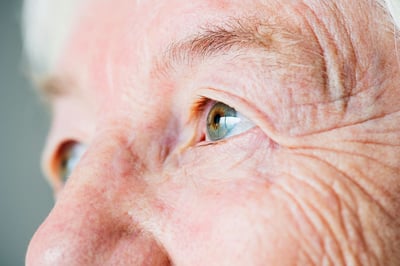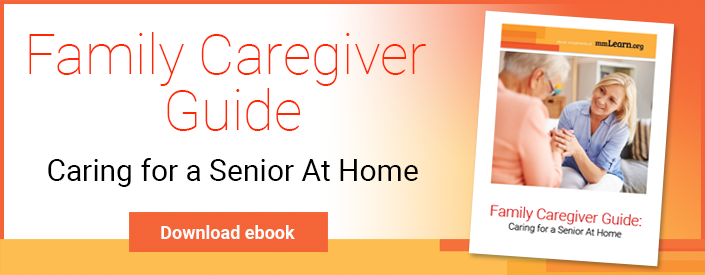 As we age, so do our body parts. There are a number of conditions that stem from aging eyes.
As we age, so do our body parts. There are a number of conditions that stem from aging eyes.
How can caregivers help recognize and treat the early signs and symptoms of eye disorders?
Here are several signs that your loved one’s eyes might need attention, according to the Mayo Clinic:
-
Holding reading material further away
-
Squinting
-
Needing extra light to perform everyday tasks
-
Blinking frequently because of dry, irritated eyes
-
Sudden or increased difficulty seeing at night
-
Complaints of spots, halos, or spidery lines in vision
In this mmlearn video, Dr. Joseph Zayac provides an overview of the anatomy of eyes and discusses common vision disorders.
Dry Eye Disease
Many seniors experience dry eyes as they age. This condition can be extremely uncomfortable and even painful, but it is not dangerous. In most cases, dry eyes are easy for seniors and their caregivers to manage or treat.
It’s important for seniors to schedule regular eye examinations to address conditions like dry eyes so they don’t develop into more serious eye diseases.
What Causes Dry Eye?
There are two main causes of dry eye: not enough tears or the amount of water in the tears.
Someone could be producing fewer tears for a variety of reasons:
-
Underlying medical conditions
-
Side effects of medications
-
General changes of aging
-
Living in a windy or dry climate (dry eye occurs because of increased evaporation of tears in these conditions)
When seniors produce enough tears yet still feel dry, they might have an insufficient amount of water in their tears. Healthy tears contain three layers: oil, mucus, and water. When the water layer is not substantial enough to lubricate the eyes, people develop keratoconjunctivitis sicca (KCS), also known as dry eye syndrome.
Dry Eye Symptoms
Dryness is quite common in seniors over age 65. However, if your loved one has KCS or dry eye disease, they can also develop other symptoms:
-
Pain, burning, and irritation in the eyes
-
A gritty or scratchy feeling beneath the eyelid
-
Feeling like something is in their eyes
-
Blurry or damaged vision
Severe cases of dry eye may lead to damage on the front surface of the eye, which can impair vision. That’s why it’s critical to seek treatment as soon as you notice signs of chronic dry eyes.
Dry Eye Treatment
When someone visits the eye doctor, the optometrist looks at their medical history for health conditions or medications that can lead to dry eyes, examines the eyes closely, and uses light and special dyes to check for abnormalities, the amount of tears produced, and the flow patterns of tears.
The doctor might prescribe a treatment for dry eyes; some of these can even improve vision. The following are some of the most common treatments for dry eye.
-
Eye drops. The most common treatment is over‑the‑counter artificial tears. There are many different brands available, and they can be used as often as needed to relieve the irritation caused by dry eyes. Caregivers might need to help administer eye drops and to help their loved ones to regulate the timing and the amount used.
-
Punctal plugs. For some people, artificial tears alone don't provide enough relief. In those cases, an optometrist might block the tear ducts with tiny devices called punctal plugs, according to the American Academy of Ophthalmology. The plugs help natural tears stay in the eye longer, lubricating the eye to reduce dryness.
-
Prescription medication. Optometrists might also prescribe medication to increase the body’s natural production of tears or prescription ointments to soothe red, irritated, inflamed eyes.
-
Supplements. For some people, omega‑3 fatty acid supplements can help with dry eyes. However, it’s best to check with a doctor before starting a new vitamin or supplement regimen.
-
Hydration. Dehydration can exacerbate dry eyes and can lead to other health problems. Encourage seniors to drink plenty of liquids, and consider a humidifier if you live in a dry environment.
Low Vision
According to the American Foundation for the Blind, more than 6 million Americans over the age of 65 experience vision loss.
Low vision is not the same as blindness. Nor is it nearsightedness or farsightedness, which are both correctable by using eyeglasses or contact lenses. Low vision describes partial vision that can be enhanced but not fully corrected.
In this mmlearn video, optometrist Dr. Sandra Fox outlines the role of a low vision optometrist and describes what to expect during an eye exam.
Common Types of Low Vision
The American Optometric Association lists the following types of low vision experiences:
-
Blurry central vision
-
Loss of side vision (also called “tunnel vision”)
-
Blurry vision for both near and faraway objects
-
Seeing glares or feeling sensitive to light even in normal lighting
-
Night blindness
Treatment Options for Low Vision
Unfortunately, most vision loss due to aging or underlying conditions cannot be retrieved. The goal of treatment is to teach someone how to perform daily tasks with reduced visual function.
This can be tough to accept because most seniors want to maintain their independence and health for as long as possible. Caregivers can encourage them by letting them know that it is possible to perform daily tasks without full vision.
In addition to participating in low vision rehabilitation therapies, seniors can benefit from learning to use low vision devices. There are many devices on the market to help your loved one maintain independence and dignity after a low vision diagnosis.
Compassionate Caregiving
Experiencing a loved one losing their vision can be stressful and disheartening, especially if the changes occur in the context of dementia. Fortunately, many treatments are available to relieve, manage, or help people cope with dry eyes or vision loss.
What can you do if you are helping care for someone with vision problems?
-
Be alert to symptoms of dry eye disorder or vision loss. Once you’ve identified an eye problem, make an appointment for your loved one to see an optometrist.
-
Help navigate treatment options. You can help the senior in your life understand their treatment options and follow through with treatment once they have a plan. This is particularly important for seniors with dementia. Consider integrating treatment into a daily routine alongside other meaningful activities for dementia patients.
-
Offer emotional support. When someone begins to lose part of their vision, there are physical and emotional consequences. Offer a listening ear or a shoulder to cry on. It’s common for seniors to grieve their loss of vision and loss of independence. You can help by reassuring them.
In this video, Dr. Sandra Fox discusses the grief and emotional consequences of vision loss for seniors. She also provides a guide for families and caregivers as they help their loved ones to navigate vision loss treatments and rehabilitation.
When seniors are aging in place, caregivers, family, and medical providers can work as a team to address the changes that occur in changing minds, bodies, and aging eyes.

